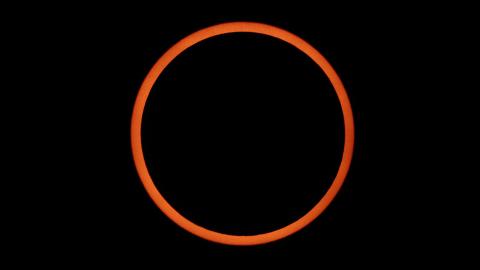
'Ring of Fire' Solar Eclipse Coming Soon, Last One Until 2039 - Here's Where to Watch
Next month, millions of people in North and South America will be able to see a special type of eclipse (if the local weather is clear) known as the "Ring of Fire."
A solar eclipse occurs when the Moon's orbit puts it between the Earth and the Sun but does not completely block the face of the sun like a lunar eclipse. Because the Moon is farther away from Earth than on average, it appears smaller than the Sun, creating a "ring of fire" effect in the sky, according to NASA.
French eclipse expert Xavier Jubier has created an interactive map showing the eclipse's entire path as it moves across the Earth.
In addition, Space.com has listed notable locations and cities that will get to see the "ring of fire" solar eclipse, along with the time and duration of the event.
 The path of the eclipse will cross eight states. Beginning in Oregon, the path will cross California, Nevada, Utah, Arizona, New Mexico, and Texas, NASA said. Even if you are not in the path of the eclipse, you will still be able to see a partial solar eclipse. If you don't get to see the "ring of fire" in person, the space agency will have a live stream available for all to view.
The path of the eclipse will cross eight states. Beginning in Oregon, the path will cross California, Nevada, Utah, Arizona, New Mexico, and Texas, NASA said. Even if you are not in the path of the eclipse, you will still be able to see a partial solar eclipse. If you don't get to see the "ring of fire" in person, the space agency will have a live stream available for all to view.
Come back to CBNNews.com to watch the live stream of the "Ring of Fire" below:
Experts warn that it is unsafe to look directly at the bright sun without using specialized eye protection designed for solar viewing, risking eye injury, according to Reuters. Because the sun is never fully blocked by the moon during this event, it is never safe to look directly at the sun without eye protection. The experts, including several medical doctors, advise using safe solar viewing glasses or a safe handheld solar viewer when witnessing the event.
Regular sunglasses are not safe for viewing the sun.
Skywatchers should also use a special-purpose solar filter if viewing the eclipse through a camera lens, binoculars, or telescope to prevent eye damage.
The event on Oct. 14 will be the last "ring of fire" to be seen in the U.S. until 2039, according to the Farmer's Almanac. The next annular solar eclipse visible from the U.S. occurs on June 21, 2039, but only Alaska and northwest Canada will see that one.
The Bible also has more to say about celestial events in general, beyond solar eclipses. The scriptures talk about signs in the heavens quite a few times, especially related to the moon and sun.
Jesus says in Luke 21:25-28, "And there will be signs in sun and moon and stars, and on the earth distress of nations in perplexity because of the roaring of the sea and the waves, people fainting with fear and with foreboding of what is coming on the world. For the powers of the heavens will be shaken. And then they will see the Son of Man coming in a cloud with power and great glory. Now when these things begin to take place, straighten up and raise your heads, because your redemption is drawing near."
And Psalms 19:1 says more broadly, "The heavens declare the glory of God; the skies proclaim the work of his hands."
***Please sign up for CBN Newsletters and download the CBN News app to ensure you keep receiving the latest news from a distinctly Christian perspective.***



